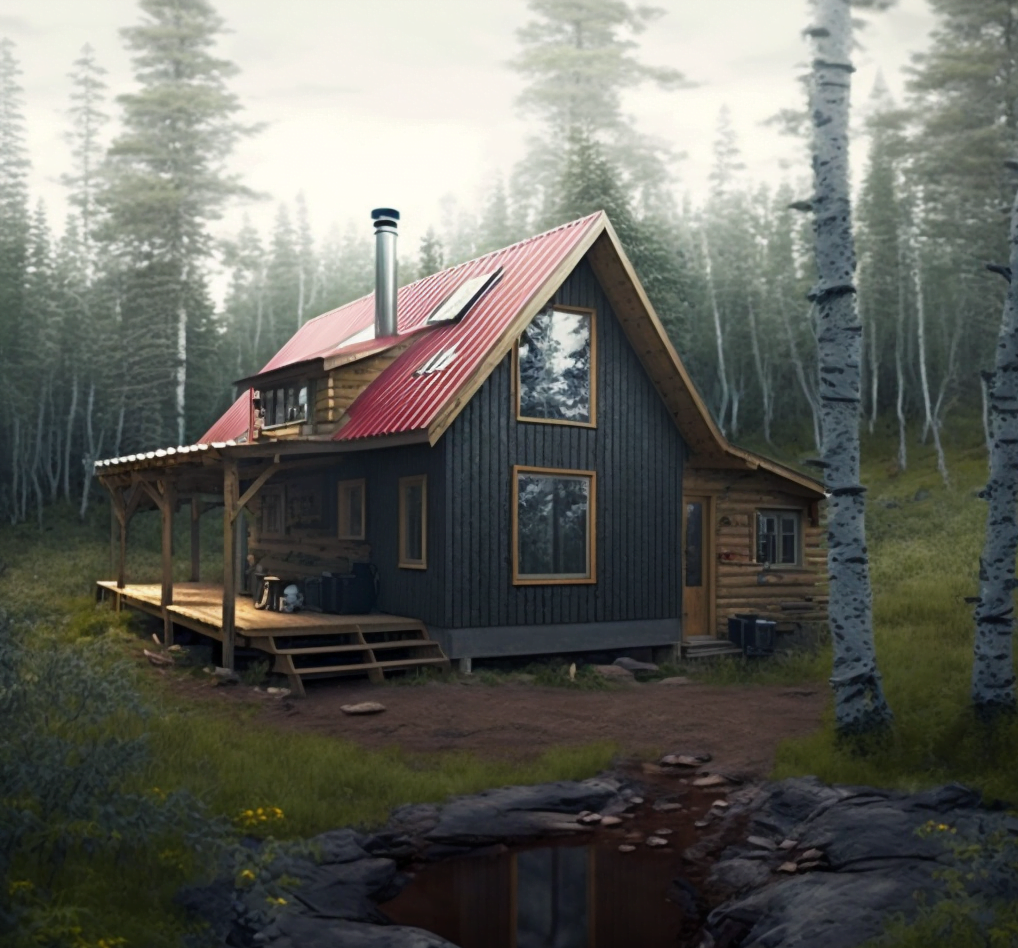Running a pellet heater off-grid is a great way to stay warm and perfect for those looking to move away from messing with firewood, especially if you want an alternative eco friendly way to stay warm. While pellet heaters do need electricity to run, unlike most wood heaters, they don’t draw very much power. Most of the power a pellet heater uses is in the first five minutes during startup to get the pellets burning and fire going. Once the fire is established, pellet heaters draw the equivalent of a few light bulbs in power. If you live off-grid or have a shed or shack off-grid that you sometimes visit, then a pellet heater can help keep you warm.

If you’ve read the post about backup power solutions for pellet heaters, there are basically three ways you can run your pellet heater when there’s no power: a generator, a UPS or an inverter with batteries. That post was aimed at people who live on-grid and only need to run their pellet heater for a short period of time before the power comes back on. If you live off-grid, then obviously you need power all the time, or at least you need power when you want to run your pellet heater. To run a pellet heater off-grid you’ll need a generator or a battery setup.
| Power Option | Pros | Cons |
|---|---|---|
| Generator | Simple to use and cheap | Noisy, fuel storage required |
| Battery backup | Quiet and scalable | Batteries expensive, limited run time |
| Solar power | Quiet and endless power source | Solar panels expensive upfront |
Generator: Simple and Straightforward Backup Power
The first and easiest option is to use a generator. Pellet heaters draw about 500 watts during startup and use around 60 watts every hour once the fire is burning. A cheap 1000 watt generator will be able to run any pellet heater. The benefit of using a generator is it’s simple and straight forward. As pellet heaters are all 240 volt, then any standard generator that puts out pure sine wave power will work. Plug your pellet heater into the generator and you are good to go. The biggest problem you’ll have is probably running the power lead from inside your house or shed where the pellet heater is to the generator sitting outside.
However, your biggest problem is going to be storing fuel to run the generator and maybe noise. Petrol or diesel will get expensive if running the pellet heater every day and for 8+ hours a day. You’ll also need to keep jerry cans full of fuel to keep the generator topped up. If you have a shed or shack that you don’t visit often, then a generator might be a good idea. Running it once a or twice a weekend when you visit won’t burn much fuel. However, if you live off-grid permanently then most likely you want to get away from using generators as they can be noisy and expensive to run if used all the time.
Battery Backup: Powering Up with Lithium or AGM Batteries
The other option to running a pellet heater off-grid is a battery backup. A UPS won’t cut it here because the batteries in them are too small. You’ll need a pure sine wave inverter and batteries. The tricky part is finding out how many batteries you need. As mentioned above, a pellet heater draws about 60 watts an hour. This means if you ran it for 12 hours a day, it would use about 720 watts (12 x 60), so we’ll say 800 watts.
You’d need a 100 ah lithium battery or a 200 ah AGM battery to run that, but that would only be for 12 hours and one day. That might be fine if you are only visiting for the weekend but not if it’s somewhere you live permanently. There are a few solutions. You know that running for 12 hours a day you’ll need about 1 x 100ah lithium battery or 1 x 200ah AGM battery. By adding more batteries you will increase the run time. So, naturally 5 x 200ah batteries would give you about 5 days of run time. If that isn’t enough then just keep adding batteries.
First, decide how many batteries you’ll need. At a minimum I would say 2 x batteries and possibly 4 x batteries would be better. The next step is to decide how you’ll recharge those batteries once they go flat. The simple solution is to use a generator, but they can be expensive to run long term, so this might be fine for the weekend shack but not for your forever off-grid home. The main downside with using batteries is the cost. Lithium batteries can be very expensive and eventually they will need to be replaced.
Solar Power: Keeping Your Batteries Charged
One solution to keep your batteries charged is to use solar. Solar panels would be hooked up to a solar charge controller, which would then be connected to your battery bank. During the day time the solar would keep your batteries topped up. At night they wouldn’t be charging the batteries but at least during the day your batteries would be charged and possibly fully charged come night time. Also, there’s a good chance you wouldn’t run your pellet heater all night, maybe 4 hours at night time, which reduces the draw on the batteries.
So how much solar would you need? At a bare minimum I would have a kilowatt of solar panels setup. This would be 4 x 250 watt panels. On a good day you’d get 4kws to 5kws of power out of the panels, more than enough to cover the 800 watts your pellet heater would need. However, not every day would be good, especially during winter, so I’d say anywhere from 200 watts to 2 kilowatts of power. Hopefully you can see that if you had a several days without sun then your batteries could potentially go flat. This is where you need to either scale up how many batteries you have and/or install more solar panels.
Proof that this actually works can be seen in what Pellet Fires Tasmania did for the 3 Capes Track cabins. They have a total of 9 pellet heaters installed in cabins that run from batteries and solar panels. These cabins are remote and a tourist attraction, so wood heaters are not a good idea considering most people would not want to split wood, plus it has to be stored somewhere dry and there’s the risk of people burning cabins down. A pellet heater connected to batteries with solar, at least in my opinion, makes for the best tiny house heater also because the heater takes up minimal space, use very little power and pellets can be stored anywhere, unlike firewood.
Off-Grid Pellet Heater Summary
Pellet heaters can be used off-grid but you will need either a generator to run them or a battery setup. If it’s just for a shed or shack then a generator or few batteries will be enough to cover a couple of days. However, if its for somewhere you live all the time, then I’d look at getting a minimum 1 kilowatt solar setup that charges a battery bank. This battery bank would then be connected to your pellet heater via a pure sine wave inverter. They really don’t use much power and I think pellet heaters are the best alternative to a wood heater if you live off-grid and are sick and tired of messing with firewood.
Resources:
3 Capes Track website
